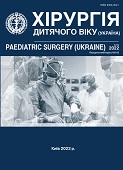Tactics of surgical treatment of congenital spinal deformities in children
DOI:
https://doi.org/10.15574/PS.2022.75.26Keywords:
halo-gravitational traction, scoliotic deformation, surgical treatmentAbstract
Progress in spinal surgery during the second half of the twentieth century was made possible by a deeper study of the three-dimensional nature of the normal and pathological architecture of the spine. The problem of complex spinal deformities remains one of the most important in clinical vertebrology. In Ukraine, more than 9,000 children need surgery for scoliosis spinal deformities. Of these, more than 15% of children have congenital scoliosis deformities.
Purpose - to conduct a retrospective analysis of the results of surgical treatment of congenital spinal deformities in children.
Materials and methods. A retrospective analysis of the results of treatment of 36 patients (from 9 to 12 years) with congenital spinal deformities who received treatment at the Department of Pediatric Surgery of the Bogomolets National Medical University (National Children's Specialized Hospital «OHMATDYT», Kyiv) in the period from 2008 to 2018.
Patients were divided into two groups: I (staged treatment) - 18 children who received treatment using halo-gravity traction (HGT), followed by spinal instrumentation; II (one-time treatment) - 18 children who underwent surgical correction with osteotomies (4-6 levels according to Ponte, VCR osteotomy at 1-2 levels).
Results. Two groups of patients were studied. According to HGT, the main arc deformation improved to 55±25%. HGT - complications were observed in 12% (transient neurological disorders). In patients who underwent spinal instrumentation without prior traction complications were observed in 37% of patients (neurological transient disorders in the form of spinal cord dysfunction).
In children with congenital spinal deformities, simultaneous implantation of the structure in comparison with staged treatment with HGT increases the risk of neurological deficits by 25%, HGT allows greater correction and adapt the spinal cord to further correction.
Conclusions. In the surgical treatment of congenital spinal deformities, HGT reduces the risk of neurological complications, reduces the time of surgery and the amount of blood loss, allows us to get better results of correction.
The research was carried out in accordance with the principles of the Helsinki Declaration. The study protocol was approved by the Local Ethics Committee of all participating institutions. The informed consent of the patient was obtained for conducting the studies.
No conflict of interests was declared by the authors.
References
Danielsson AJ, Wiklund I, Pehrsson K, Nachemson AL. (2017). Health-related quality of life in patients with adolescent idiopathic scoliosis: a matched follow-up at least 20 years after treatment with brace or surgery. Eur Spine J. 10 (4): 278-288. https://doi.org/10.1007/s005860100309; PMid:11563612 PMCid:PMC3611508
Everitt BS, Skrondal A. (2010). The Cambridge Dictionary of Statistics. Ed. 4. Cambridge University Press: 480. https://doi.org/10.1017/CBO9780511779633
Glotzbecker M, Johnston CE, Miller P. (2014). Is there a relationship between thoracic dimensions and pulmonary function in early-onset scoliosis? Spine. 39: 1590-1595. https://doi.org/10.1097/BRS.0000000000000449; PMid:24875963
Harms LR, Andras LM, Sponseller PD et al. (2018). Comparison of percen- tile weight gain of growth-friendly constructs in early-onset scoliosis. Spine Deform. 6: 43e7. https://doi.org/10.1016/j.jspd.2017.05.005; PMid:29287816
Johnston CE, Tran DP, McClung A. (2017). Functional and radiographic out- comes following growth sparing management of early-onset scoliosis. J Bone Joint Surg Am. 99: 1036-1042. https://doi.org/10.2106/JBJS.16.00796; PMid:28632593
Levytskyi AF, Rogozinskyi VA, Dolianytskyi MM. (2020). Halo-gravity traction in the treatment of complex (>100°) scoliotic deformities of the spine in children: a review of clinical cases. Paediatric Surgery.Ukraine. 4(69):67-71. https://doi.org/10.15574/PS.2020.69.67
Li X, Zeng L, Li X, Chen X, Ke C. (2017). Preoperative halo-gravity traction for severe thoracic kyphoscoliosis patients from Tibet: radiographic correction, pulmonary function improvement, nursing, and complications. Med Sci Monit: 4021-4027. https://doi.org/10.12659/MSM.905358; PMid:28822231 PMCid:PMC5572782
Meirte, Jill et al. (2014). Classification of quality of life subscales within the ICF framework in burn research: identifying overlaps and gaps. Burns 40 (7): 1353-1359. https://doi.org/10.1016/j.burns.2014.01.015; PMid:24685352
Rohozynskyi VO, Levytskyi AF, Dolianytskyi MM, Benzar IM. (2020). Treatment of Severe Spinal Deformations in Children with Idiopatic Scoliosis Using Halo-Gravity Traction, Wiadomości Lekarskie J. 10 (73): 2144-2149. https://doi.org/10.36740/WLek202010107; PMid:33310937
Vasiliadis E, Grivas TB, Gkoltsiou K. (2016). Development and preliminary validation of Brace Questionnaire (BrQ): A new instrument for measuring quality of life of brace treated scoliotics, Scoliosis. 1: 7. https://doi.org/10.1186/1748-7161-1-7; PMid:16759366 PMCid:PMC1481574
Yang C, Zheng Z, Liu H, Wang J, Kim YJ, Cho S. (2016). Posterior vertebral column resection in spinal deformity: a systematic review. Eur Spine J. 25 (8): 2368-2375. https://doi.org/10.1016/j.wneu.2020.03.044; PMid:32194269
Downloads
Published
Issue
Section
License
Copyright (c) 2022 Paediatric Surgery (Ukraine)

This work is licensed under a Creative Commons Attribution-NonCommercial 4.0 International License.
The policy of the Journal “PAEDIATRIC SURGERY. UKRAINE” is compatible with the vast majority of funders' of open access and self-archiving policies. The journal provides immediate open access route being convinced that everyone – not only scientists - can benefit from research results, and publishes articles exclusively under open access distribution, with a Creative Commons Attribution-Noncommercial 4.0 international license(СС BY-NC).
Authors transfer the copyright to the Journal “PAEDIATRIC SURGERY.UKRAINE” when the manuscript is accepted for publication. Authors declare that this manuscript has not been published nor is under simultaneous consideration for publication elsewhere. After publication, the articles become freely available on-line to the public.
Readers have the right to use, distribute, and reproduce articles in any medium, provided the articles and the journal are properly cited.
The use of published materials for commercial purposes is strongly prohibited.

